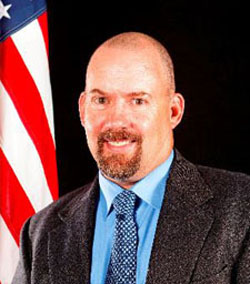Interview
Montrose County, Colo., Land Use and Property Taxes
By Kate Burke
[September 21, 2016, The Bridges, Montrose, Colo.]. At quarterly meeting of members and affiliates of the Montrose Assoc. of Realtors, which is open to the public, guests attending learned a lot about Montrose land use and property taxes, both complex subjects.
 Steve White, Montrose County Planning and Development Director
Steve White, Montrose County Planning and Development Director
Mr. White addressed a lot of public questions about land use and road building. Building permit applications are way up, he said, standing at 85SFR right now. (There were 56 in 2016 and 69 in 2015.) “We should make 100 by the end of the year,” he said. Surprisingly, 80% of subdivision applications are for boundary line adjustments, most initiated from estate planning. Plats older than 20 years may not be accessible on the assessor’s website, and boundaries can be nebulous. White also noted that there is a lot of inventory from when developers came in around 2007-2008, and the market dried up. Farmers are using the paved infrastructure for their tractors and hay bailers, waiting until the market returns for subdividing and selling off farmland. “Right now, we’ve got enough inventory for ten years,” he said. The other issue is that any subdivision must front on a county road, which lets out a lot of the mountain property. Lack of water is another issue.
Concerning roads, White said that the county paves about 10 miles of road per year, totally resurfacing so roads will last longer. Most of the work is done by contractors, and county road crews concentrate more on repairs. The new road and bridge building on LaSalle, will include equipment, maintenance, and the new fleet shop.
Discussing code enforcement, White said, “Junk cars and household trash are the biggest problems.” Code is being changed in the business district zone to allow mini-storage and car repairs. Also being discussed is long-term-living RV Parks. This brought up an interesting discussion on ‘tiny houses,’ which have become popular. “If it’s on wheels, it’s an RV and has (license) plates,” he said. “If it’s on a permanent foundation, it requires a permit.” One problem is with tiny homes,” he noted, is there is “no place for all your stuff, so your junk just collects outside, and can turn the area into a slum.” So code enforcement will be very important.
There was also a lively discussion about what is and what is not classified as “ag property,” and the financial considerations of permitting versus property taxes, something which was discussed further by Mr. Hughes.
 Brad Hughes, Montrose County Assessor
Brad Hughes, Montrose County Assessor
Mr. Hughes, gave a Power Point Presentation, discussing trends in property valuations and how property tax is calculated. Colorado has one of the lowest residential property taxes in the country—7.9%. To offset the discount, commercial property taxation is above the national average, at 29%. “Residential property is valued per unit,” he explained, and a unit could be an acre (or whatever size one parcel is). Agricultural property is not based on residential value. This is important to understand, because the majority of Montrose County is zoned agricultural.
Developers get a nice discount for holding lots in inventory, and this is passed on to the buyer—until a new tax valuation is done, generally the year following the property purchase.
Hughes also pointed out that “comps” (comparisons of like- or similiar-property sales) are misleading. Assessments are two years behind market value, and raw MLS listings don’t help. Appraisers tend to target a number (loan amount) rather than the property’s actual value. A spate of foreclosures and bank-owned property sales aren’t helping to determine market value or assessed value. Also, some of the properties have not been sold for some time, so buyer and seller (and lender) need to do some research to determine value.
[Ed. Both of these stories were approved, with corrections, by the interviewees prior to publication.]
Click here to add your own text

 © Bill Colley
© Bill Colley